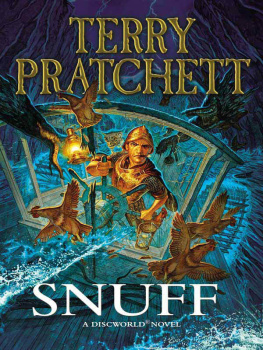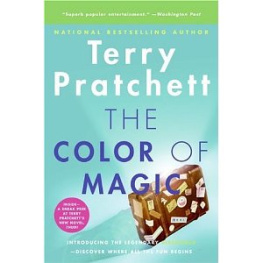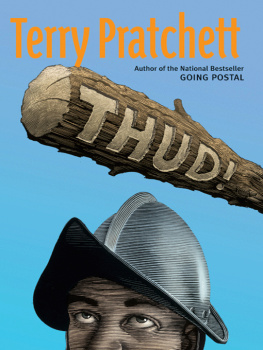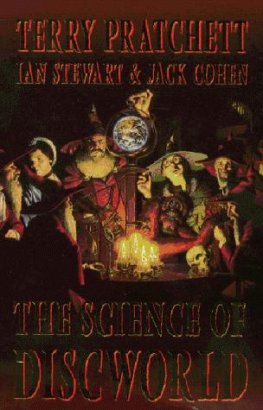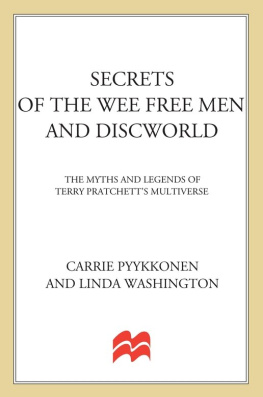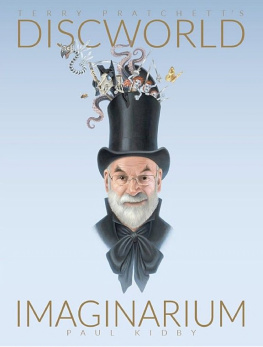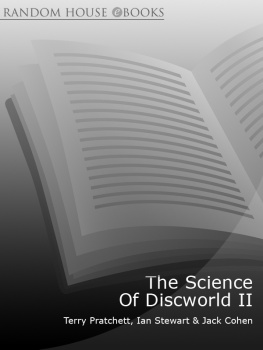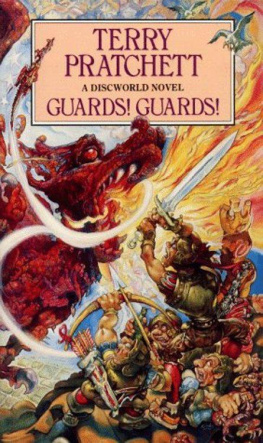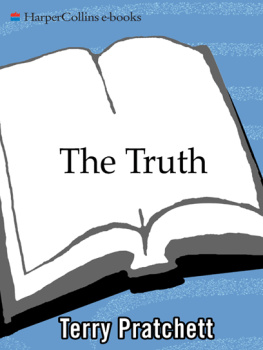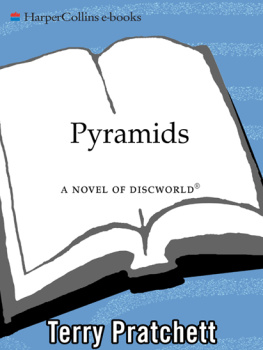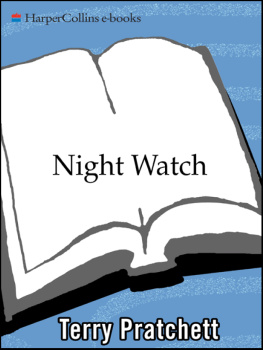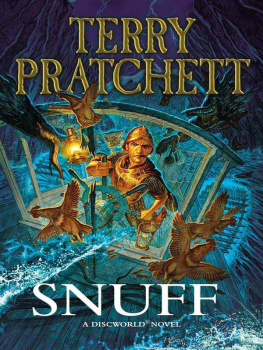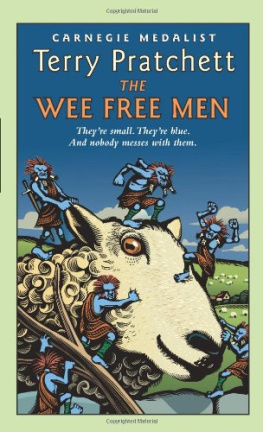Contents
Guide
CONTENTS
TERRY PRATCHETT
Professor Sir Terry Pratchett OBE was the creator of the hugely successful Discworld series of novels and during his lifetime became Britains bestselling author of adult fiction.
His first published story, Business Rivals, was printed in his school magazine and then published in Science Fantasy magazine when he was just fourteen. Using the proceeds, Terry purchased his first typewriter.
He left school aged seventeen and worked as a journalist for his local newspaper, the Bucks Free Press. His first novel, The Carpet People developed from stories he had written for the weekly childrens section of the newspaper was published in 1971.
In 1979 Terry was appointed publicity officer for the Central Electricity Generating Board, where he remained until 1987. During this time, he wrote the first four Discworld novels The Colour of Magic, The Light Fantastic, Equal Rites and Mort. In September 1987, after completing Mort, he gave up his job at the CEGB and devoted himself fulltime to writing.
His interests were wide-ranging and eclectic, and are reflected in his books, which are littered with esoteric ideas and wisdom from beekeeping, folklore and cheese-making, to quantum mechanics, astronomy and the finer aspects of Morris dancing.
Terry was appointed Officer of the Order of the British Empire (OBE) in 1998 and knighted for services to literature in the 2009 New Year Honours. He used the latter accolade as justification for forging his own knightly sword Thunderbolt Iron using iron he smelted himself.
In 2001, he won the Carnegie Medal for The Amazing Maurice and His Educated Rodents and went on to receive many literary awards, ten honorary doctorates and the World Fantasy Award for Life Achievement, eventually earning the full title of Professor Sir Terry Pratchett, OBE, Blackboard Monitor, Adjunct of the Oscar Wilde Centre for Irish Writing and the School of English at Trinity College Dublin.
In 2007, Terry announced that he was suffering from posterior cortical atrophy, a rare form of Alzheimers disease. Despite this embuggerance, as he came to call it, he subsequently penned a further twelve bestselling novels, made several award-winning documentaries and campaigned tirelessly for Alzheimers research and the right to die with dignity.
Terry died peacefully in March 2015 at his home in Wiltshire, with his family by his side and his cat asleep on his bed.
His final request was that the hard drive containing his unfinished novels be either crushed by a steamroller or fired into space. His assistant and friend, Rob Wilkins, chose the former, having decided that launching a rocket from their rural office in Wiltshire might be impractical.
STEPHEN BRIGGS
Stephen Briggs was a collaborator with, and friend of, Terry Pratchett for more than 20 years.
They worked together to build the city of Ankh-Morpork, to create the Discworld on which it stands, and to put together a Companion to Terrys wonderful world.
Stephen went on to collaborate with Terry on a number of spin-offs which expanded on the institutions and geography of his possibly fictional world. He has also dramatized twenty-two of Terrys novels (so far) and recorded Terrys unabridged audio books for various publishers in the UK and US.
Terry used to say of Stephen: He knows more about Discworld than I do. Less flatteringly, he described Stephen as Bosworth (sic) to his Dr Johnson hopefully, he was joking.
For those unfamiliar with British history, Bosworth was the battlefield which saw the death of King Richard III the last English monarch to die in combat. Dr Johnsons sidekick, as Terry well knew, was called Boswell.
PAUL KIDBY
Paul Kidby has been wielding a pencil all his working life. As a young school leaver he was determined to teach himself the skills and discipline required to become a designer and illustrator. Paul read his first Discworld novel in his late twenties.
This was a seminal moment. Inspired to design and illustrate characters from The Colour of Magic, he hand-delivered his artwork to Terry Pratchett after queuing to meet him at a book signing. It was the beginning of a dynamic creative collaboration between author and artist, Terry wrote that he liked the reality of Pauls work, and the feeling that he had just strolled into the books with a sketchpad.
Almost thirty years and many publications later, Paul has an astonishing archive of Discworld artwork, some of which can be seen here for the first time.
Toto, Ive a feeling were not in Oxford any more.
When I look back over the years since I last revised the introduction to the Companion, I am staggered at how much has happened.
My original introduction to the first Discworld Companion said: Six years ago I was a civil servant who dabbled in amateur dramatics (er I still am).
Ive now left the civil service; it was taking over all my time. I dont think that the work/life balance exhibited by Scrooge and Cratchit at the start of A Christmas Carol is actually a sound way forward in fact, I firmly believe that a work/life balance is intended, implicitly, to include an element of life.
As many of you know, I fell into Discworld backwards, as if Id been leaning on a rickety old door in a walled garden and Id suddenly found myself in a magical kingdom full of snow, fauns and benevolent lions. I hadnt meant to be here, but Im jolly glad that I am.
I came across Discworld while looking for books to dramatize for my amateur drama club. We were the first people anywhere in the world to dramatize the works of Terry Pratchett. When I first wrote to Terry back in 1990 to ask permission to dramatize Wyrd Sisters, I little realized that in choosing that book to dramatize, I had made a really BIG life choice. I can still remember how worried we were when the author (then Mr Terry Pratchett) actually telephoned me in person to say that he wanted to come and see our little production. Would he like it? Would he let us do any more?
Wyrd Sisters went so well that we went on to stage twenty more Discworld books (so far!) plus three written for use by schools. Most of these have now been published, and have been staged by amateur drama clubs all over the world Australia to Zimbabwe, Indonesia to Bermuda, Finland to France, South Africa to the USA. Even in the Antarctic how cool is that? Along the way, theyve raised tens of thousands of pounds for the Orangutan Foundation from their royalties.
Anyway, back to 1992. One day, when I was working on only my second Discworld play, I mentioned to Terry that I was convinced from my reading that Ankh-Morpork had a distinct shape. He doubted it he said hed just put buildings and streets in wherever the plot required them. I said that in this world they got put in wherever History demanded them and I was sure the city was mappable. Fine, he said. Go ahead.
And that led to The Streets of Ankh-Morpork, published in 1993, possibly the first map ever to get into the bestseller lists.
The arguments er, discussions and constant reference-seeking involved in that project led me to wonder out loud if it wasnt time for a guide to Discworld.


